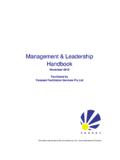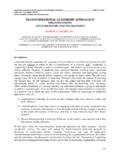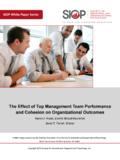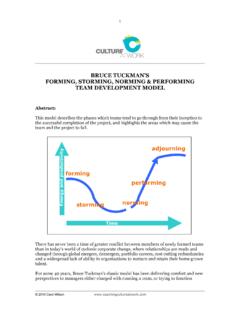Transcription of 06 The OCM Coach and Mentor Journal 2014 Integrating ...
1 06 The OCM Coach and Mentor Journal 2014 Diane NewellIntegrating coaching and mentoring in OrganisationsThe OCM situational Coach - mentoring styles continuumA key part of The OCM philosophy and approach to coaching and mentoring is flexibility. We believe that coaches and mentors (or Coach -mentors as we style ourselves) should be aware of and be able to practise skilfully across the coaching and mentoring spectrum in order to best serve their clients and the contracts they have with them. However, in many organisations that we work with, coaching and mentoring are seen as two separate practices even though they share many of the same skills and this article is born of my curiosity about why this is. What is it that drives that need to separate? And what might organisations gain or lose in doing so? In this article, I set out to share what I have observed myself and heard from others. I will list some of the risks that organisations perceive in this separation, and some of the potential benefits.
2 I have asked a number of clients and contacts to comment, and my intention is to explore the issues and options rather than present a solution although I have shared my current observations and opinion. My intention is to discover whether it is worthwhile challenging the perception that coaching and mentoring should be developed and managed independently of each other. Also, to consider whether there are pragmatic solutions that might work with the issues that drive separation whilst addressing some of the potential risks of doing years on from my first ventures into coaching and mentoring , there s quite a bit of it going on in organisations. Internal coaches and mentors, many of whom are highly trained and qualified, are spread across organisations in a variety of more-or- less explicitly recognised roles. Organisations may have official mentoring schemes for a variety of populations as well as unofficial mentoring relationships. There may be formal and informal peer coaching groups, officially recognised internal coaches, and groups of people (often in HR) unofficially acting as coaches to leadership teams.
3 And as the effectiveness of coaching styles is increasingly recognised, leaders and managers are expected to act as performance and development coaches to their teams and direct reports. As well as all of this internal coaching and mentoring practice, external coaches (and very occasionally external mentors) may be contracted officially (often through HR managed schemes) and unofficially through personal contacts and theory, all of this effort and investment exists in service of both the organisation s strategy and the personal development and growth of the individuals within the organisation . But, in practice, I observe that most organisations even those that have been early adopters of coaching and mentoring are only just beginning to think seriously about how to use their full range of coaching and mentoring resources in a strategic way. Not because they are in some way lacking, but as an inevitable result of the way in which coaching and mentoring has developed in their how did we get here?
4 And what are the implications? Many of the schemes and initiatives that contain and support coaching and mentoring are managed in different parts of the organisation , and have been started with different motivations and agendas. There have been, and still are, some real benefits to this dispersion. In particular, it has allowed early supporters of coaching and situational Coach - mentoring styles continuumSkillsPerformancePotentialPerso nalFinite/concreteRole/competencesComple x/evolvingShort termMedium termLonger termAuthoritative/directiveContext drivenNon-directive Just because it is simple, doesn t make it easy to do! Eric OCM Coach and Mentor Journal 2014 07mentoring in organisations to develop creative, innovative approaches without trying to eat the elephant . It allowed local managers to create approaches that met local needs, fitted with local cultures and values, and to respond more rapidly to individuals in their regions or functions.
5 It has produced test beds in which the value of coaching and mentoring can be proved and acceptance of the approach built. But as organisations pass out of the first developmental stages of coaching and mentoring , there are also some risks, and some unrealised opportunities inherent in this fragmentation. In the box below, I have listed some of these risks and unrealised opportunities which Katherine Ray (Global Talent Capability Manager, HR at Unilever) and I identified in a conversation with other members of the ideal solution is to preserve flexibility in the implementation of coaching and mentoring while addressing the risks and unrealised opportunities that are most relevant to the particular organisation . To find such an ideal solution requires leadership generally, and the HR/L&D and OD functions in particular, to develop a clear and shared insight into what coaching and mentoring could and should uniquely contribute to strategic success in their particular context.
6 It also means developing and implementing policies, processes and resources that address those needs effectively. Easy for me to write, but hard to do in practice. Many talent teams would love to centralise coaching and mentoring in order to manage its risks and focus its benefits. But to do so can create gates or barriers to accessing coaching and mentoring resources which may dissuade managers from using coaching and mentoring , or which may create perverse incentives for managers to work around the process. Managers may access resources in ways that are easier for them, but which inevitably keeps both their use of coaching and mentoring and its impact under the radar in the organisation . Even with the best of intentions, such an approach might exacerbate the risks and lost opportunities for the organisation and undermine progress towards creating a coaching own current study of what works at this point in the development of coaching and mentoring in organisations is summarised in the box below.
7 It s not a complete framework and none of this is rocket science . But as our founder, Eric Parsloe, always says, Just because it is simple, doesn t make it easy to do! What are the risks? Quality/safety issues as growth of dependence on coaching relationships, especially external coaches and organisations, may lead to breached confidentiality. Confusion, which can create inefficiency as individuals may not know where or how to access the right help. Furthermore, confusion of mentors and coaches as to what is expected of them in their roles. Lack of transparency means the organisation cannot see what it is investing in and how it is adding value. Lack of integration of the coaching and mentoring efforts with other developmental initiatives, organisational resources (for example, talent development) and up-skilling/training. Also, potential disengagement ( Oh, I tried that coaching thing. It didn t work for ).What are the unrealised opportunities?
8 Learning and support between coaches and mentors in terms of shared skills, approaches and insights into the particular organisational context. Organisational Learning coaches and mentors have insights to what s going on in the organisation ; by bringing these together they can reflect back to the organisation in a way that enables the organisation to gain insight. Role of coaching and mentoring becoming part of management and leadership DNA. Greater impact on the individual when coaching and mentoring are The OCM Coach and Mentor Journal 2014 Integrating coaching and mentoring in Organisations (cont.)Thoughts from our Network: A really thought provoking article. I was struck by the notion of unrealised opportunities possibly arising from the way the organisation structured their coaching and mentoring services. When the focus shifts from embedding coaching and mentoring to consciously realising its full potential, there is a marked release of energy leading to renewed purpose.
9 This is a noticeable outcome when supervision is integrated into organisational coaching (The OCM Journal 2012). It is also evident in the enthusiastic transfer of dynamic reflective practice in the moment , at transition and forward into management DNA by individual leader coaches . How much more flexible and agile could an organisation be strategically if reflective practice and critical thinking are integrated into the way we do business round here ? Angela Hill, Business Coach , The OCM I really like where you re going with this idea. As an experienced internal team Coach I am most interested in how we extend our coaching strategy to cover teams and in the ideas on team mentoring . Build a collective understanding of the risks and missed opportunities that the status quo represents by sharing stories and discussing widely with key influencers and sponsors. Don t be inhibited if all of the strategic links aren t in place for you but do link what you are seeking to alter to the management of risks and the accessing of benefits that have real current value to the organisational agenda.
10 Be clear about what your policies, strategies and processes are targeting. Specifically, I think it is well worth being clear about the difference between Coach - mentoring as a skill or a managerial approach and specific coaching or mentoring relationships. Your managers may be confused by being told that they need to be a Coach . It can lead to them under-valuing contracted Coach - mentoring relationships for themselves and others. Unless you want your managers to be internal coaches, they don t need to be a Coach ; they need to be a manager who skilfully uses Coach - mentoring skills as part of their responsibility to manage the performance and development of their team. It may be important to define the purpose of coaching relationships and to specify their strategic intent separately and differently from the purpose and intent of mentoring relationships in your organisation . But, be wary about starting a debate about what coaching or mentoring is.






